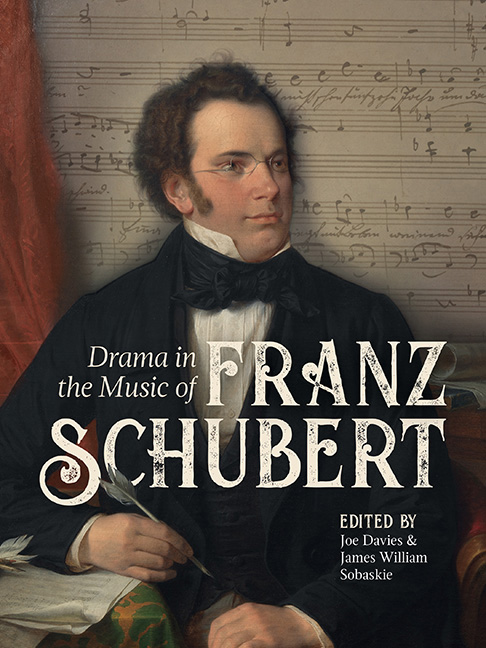Book contents
- Frontmatter
- Dedication
- Contents
- List of Figures
- List of Tables
- List of Contributors
- Acknowledgements
- Preface
- Introduction: Internal Dramas
- PART I STAGE AND SACRED WORKS
- PART II LIEDER
- PART III INSTRUMENTAL MUSIC
- 9 ‘Zumsteeg Ballads without Words’: Inter-Generic Dialogue and Schubert's Projection of Drama through Form
- 10 Lyricism and the Dramatic Unity of Schubert's Instrumental Music: The Impromptu in C Minor, D. 899/1
- 11 Music as Poetry: An Analysis of the First Movement of Schubert's Piano Sonata in A Major, D. 959
- 12 Virtual Protagonist and Musical Narration in the Slow Movements of Schubert's Piano Sonatas D. 958 and D. 960
- 13 Stylistic Disjuncture as a Source of Drama in Schubert's Late Instrumental Works
- Select Bibliography
- Index
12 - Virtual Protagonist and Musical Narration in the Slow Movements of Schubert's Piano Sonatas D. 958 and D. 960
from PART III - INSTRUMENTAL MUSIC
Published online by Cambridge University Press: 25 March 2020
- Frontmatter
- Dedication
- Contents
- List of Figures
- List of Tables
- List of Contributors
- Acknowledgements
- Preface
- Introduction: Internal Dramas
- PART I STAGE AND SACRED WORKS
- PART II LIEDER
- PART III INSTRUMENTAL MUSIC
- 9 ‘Zumsteeg Ballads without Words’: Inter-Generic Dialogue and Schubert's Projection of Drama through Form
- 10 Lyricism and the Dramatic Unity of Schubert's Instrumental Music: The Impromptu in C Minor, D. 899/1
- 11 Music as Poetry: An Analysis of the First Movement of Schubert's Piano Sonata in A Major, D. 959
- 12 Virtual Protagonist and Musical Narration in the Slow Movements of Schubert's Piano Sonatas D. 958 and D. 960
- 13 Stylistic Disjuncture as a Source of Drama in Schubert's Late Instrumental Works
- Select Bibliography
- Index
Summary
Introduction
Those philosophers or philosophically oriented musical scholars who have addressed the relationship between music and emotions have often asked the following perplexing question: whose emotions are we talking about when we associate music with emotions? Although there is a wide variety of opinion, recent contributions to the debate can be divided into two main categories. On the one hand, there are scholars who argue that when we discuss music in emotive terms, we are essentially referring to emotional abstractions that are not felt by anyone. Stephen Davies, for example, speaks of ‘emotion characteristics in appearances’ that refer to publicly displayed emotional signs that we can recognize without associating them with anyone's real, felt emotions.
In contrast to such views, there are scholars who argue that the emotions we associate with music are those felt by a ‘virtual musical persona’, a kind of implicit protagonist who traverses through a musical work, experiencing the emotions that the work is said to display. Edward T. Cone asserts that ‘a dramatic impersonation underlies all poetry, all fiction, indeed all literature worth the name’, and then avers that an analogous persona can be established in music. Jenefer Robinson emphasizes that through references to this kind of a ‘virtual musical persona’ we can discuss emotions so finely nuanced that their recognition through appearances only would be impossible. In this way, ‘cognitively complex emotions can be expressed by instrumental music without words’. Robinson and Robert Hatten, in turn, note that ‘one of the appealing features of the persona theory of musical expressiveness is that it allows for emotions … to be represented in music by musical processes’. That is, they argue that persona theory may provide a foundation for musical narration.
This essay is a case study in musical narrativity in the slow movements of Schubert's Piano Sonatas in C minor, D. 958, and Bb major, D. 960 (1828). I will examine the interplay between two virtual musical personae. On the one hand, central to both movements’ narration is a ‘protagonist’, a positive musical agent. The listener sympathizes with the protagonist. On the other hand, both movements feature an antagonist, a negative musical agent.
- Type
- Chapter
- Information
- Drama in the Music of Franz Schubert , pp. 283 - 302Publisher: Boydell & BrewerPrint publication year: 2019



